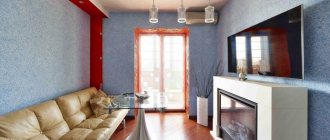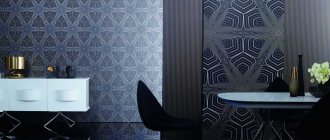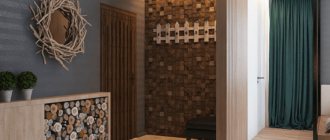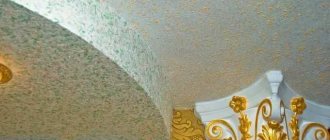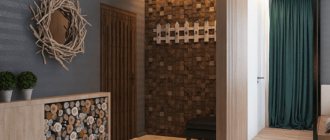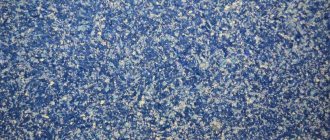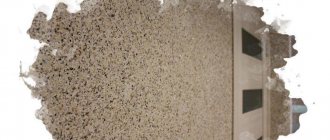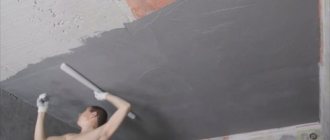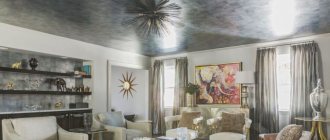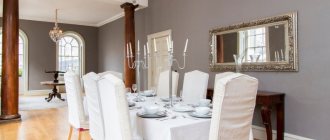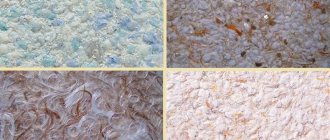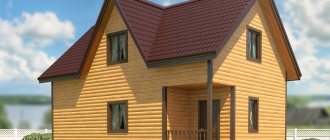What is liquid wallpaper?
There are opinions that liquid wallpaper is one of the variations of plaster for surface finishing or a combination of paper wallpaper with plaster. It is worth noting that these concepts cannot unambiguously answer the meaning of the term “liquid wallpaper”.
Wallpaper made from liquid materials may include elements of cotton and silk, mica, sand mixture of different grain sizes, and more.
They can be used for finishing home, office, and industrial premises, due to the varied color palette, abundance of textures and application of all kinds of patterns.
Liquid wallpaper: advantages
Like any finishing material, liquid wallpaper has ardent fans and those who do not quite like this type of surface finish. The first focus on the following advantages:
- absence of joints and seams on the finished surface. It is smooth and has no defects;
- Using the material correctly, you can level out any imperfections on the wall surface, although this will increase the consumption of the mixture;
- the mixture is easily permeable to steam, which means there is no need to worry about an imbalance in the humidity balance in the room;
- you can lay out curved walls and ceilings;
- Mechanical damage to the finished masonry is not scary; there are two ways to restore it: for small scratches and defects, the area is wetted and after a couple of minutes it is leveled with a spatula. And if the damage is severe, there is a change in color, the old coating is cleaned off and a patch of the same mixture is applied;
- The renovated room receives additional insulation, both sound and thermal.
As you can see, the range of advantages is extensive. Practical people will appreciate, first of all, the ability to restore damaged wallpaper, which is indispensable if, for example, there are animals in the house.
Advantages and disadvantages of liquid wallpaper
The advantages of wallpaper made from liquid materials include: resistance to sub-zero temperatures and sudden temperature changes, resistance to fading in the sun, ease of application and rinsing from the surface, insulation from sounds.
This wallpaper is environmentally friendly. They can be used on surfaces that are difficult to access.
The disadvantages of such wallpaper are: use only in dry rooms, cleaning with dry rags, high cost.
Making liquid wallpaper with your own hands is quite simple. It is enough to have a large amount of paper and time in stock.
Which color to choose for liquid wallpaper: 5 main aspects
Owners who have decided to get a specific shade by adding color to liquid wallpaper are wondering what color to choose and how to get it. Wallpaper of this type is of excellent quality, since it can be painted more than once, but for such coloring you need to know the properties of the color.
When choosing a color for liquid wallpaper, it is imperative to take into account the saturation and brightness of the color
In order to choose a tinted dye for liquid wallpaper, you need to pay attention to the following points:
- Brightness and color saturation;
- Service life and other characteristics;
- Resistance to abrasion and fading;
- Maintenance and ease of care;
- Affordable price.
In large construction stores or special stores for such sales profiles, customers are provided with an automatic tinting service, that is, the buyer selects the color they need or like and, using a computer, specialists calculate the amount that needs to be added for the renovation work of a given room. If desired, specialists can dilute the entire volume of paint at once. But you should take into account that during work the shade of the color you choose may change due to the fact that the amount of light in the room is different. To avoid such embarrassment, you need to apply the color you have chosen on a white sheet of paper, let it dry and bring it to a white wall, keep in mind that such an amount will not be saturated on a large surface. If such paint is produced at a point of sale, it must be used within 2 hours. If you do not cover the walls within these 2 hours, there are effects of color shade mutation. You can see how this happens in the photo.
Master class - how to make liquid wallpaper with your own hands
- Shred paper (of any format, regardless of its purity) into small pieces measuring 3–4 centimeters.
- Fill the paper with water until it is completely covered. Leave until completely soaked, about 2 - 3 hours.
- Grind the soaked paper into a uniform mixture using a steel mixer.
- Add a color palette, plaster, glue (for 1 piece of paper - 1 teaspoon of plaster and 5 ml of glue). Mix. If necessary, add decorative elements (sand, mica and others).
- Apply to a previously prepared and dry surface with a layer of 3 – 4 mm. Let dry.
How to apply liquid wallpaper?
- Dilute the dry mixture according to the instructions and let it brew for 12 hours. Stir before use.
- It is better to stir the liquid mixture without using mechanisms, as this destroys the structure of the wallpaper.
- Use a metal spatula to evenly apply wallpaper to the surface.
- One surface should be made of one mixture to avoid visible transitions.
- The thickness of the wallpaper should not exceed 4 - 5 mm. For the initial layer - 2 - 3 mm, and for the final layer 2 mm.
- Allow the wallpaper to dry for 2 – 3 days.
Making drawings with liquid wallpaper
- Draw a sketch of the design with a pencil on the surface.
- Apply the mixture with a spatula along the outline of the sketch.
- Let the dates dry (3 – 4 hours). Apply a different color. Distribute the amount of mixture evenly.
An excellent solution when decorating the interior of a bedroom, children's room, or hallway would be to use wallpaper made from liquid materials.
The only rooms where such wallpaper should not be used are the kitchen and bathroom. In the kitchen there is a high probability of rapid contamination; in the bathroom there is high humidity.
Recommendations for use
Liquid wallpaper in the interior of premises is perfectly combined with other types of decoration. By combining the material with artificial stone or photo wallpaper, you can achieve original effects. A pattern on a ceiling or wall will glow and look in the dark if you add fluorescent paint to the mixture.
The coating is often used to decorate bedrooms and living rooms. The soft and pleasant to the touch material is perfect for children's rooms. In addition, children love to draw on the walls with pencils and paints, and with this wallpaper, all damaged areas can be easily replaced with a new coating.
Living room design
The living room is the central part of the apartment. The whole family receives guests here and spends more time. Designers quite often suggest using liquid wallpaper to decorate this room:
- To create an original interior in the living room, wall design using liquid wallpaper with a non-uniform or uneven texture will help, which will give the surface a plaster effect. This effect can be enhanced if granules and flock are added to the composition.
- It is better to decorate a large room with large drawings. Usually the design is applied to only one part of the wall.
- Visually, the high ceiling in the room will become lower if horizontal lines are applied to the walls. Conversely, vertical stripes will help increase the height of the walls.
- Silver and gold shades look good in living rooms with palace interiors.
The room will take on a stylish look if the wallpaper on the wall is in harmony and ideally matches the curtains, sconces and furniture. In addition, you should pay attention to the fact that carpets, if used, and decorative elements are combined with the interior.
Liquid wallpaper in the bedroom
To add warmth and comfort to the bedroom, you can add silk fiber to the liquid wallpaper.
The inclusion of shimmering elements in the mixture will create a unique stardust atmosphere.
Plaster with golden shimmer will add sophistication and luxury. Places that have cracks and unevenness will sparkle with a new golden light, which will give the room a unique depth with a brilliant glow.
What is liquid wallpaper
Liquid wallpaper is often confused with decorative plaster. Rather, because in both cases the technique of application to the surface is the same. The master uses a spatula for installation, but the composition of liquid wallpaper is fundamentally different from plaster. Here the basis is made up of silk, cotton and cellulose fibers, bound together with thick glue.
Initially, this is a dry composition that must be diluted with water to obtain building material. The mass obtained according to the instructions should be applied to the working area of the wall or ceiling. The coating turns out to be seamless and monochromatic; such wallpaper is a good option to smooth out minor dents and bulges.
The decorative effect of the mixture is achieved using acrylic dyes. Some people like the surface not to be a single color, but with various inclusions, for which purpose they add sparkles of different sizes, threads of mother-of-pearl, such decorative inclusions are called “glitters”.
When choosing liquid wallpaper, sample photos may have different shades and colors. Buyers will also be pleased with the matte sheen obtained on the basis of “liquid silk”. And cotton-based liquid wallpaper will also be matte, but will look visually different.
It is also possible to reduce the gloss level by developing mixed formulations.
Decorating a room for children
Decorating a room for children with wallpaper made from liquid materials looks richer and more comfortable compared to ordinary painting.
The room can be decorated with a design you and your baby like. Such wallpapers are safe and environmentally friendly. If your child colors the wallpaper, you can always update it.
RELEVANCE OF WALLPAPER WHEN FINISHING ROOMS FOR VARIOUS PURPOSE- Decorative brick wallpaper in the interior: types and design features (70+ photos)
How to choose armored doors
With the help of a variety of such wallpapers and the use of various elements in their composition, you can always make your room unique and designer stylish.
